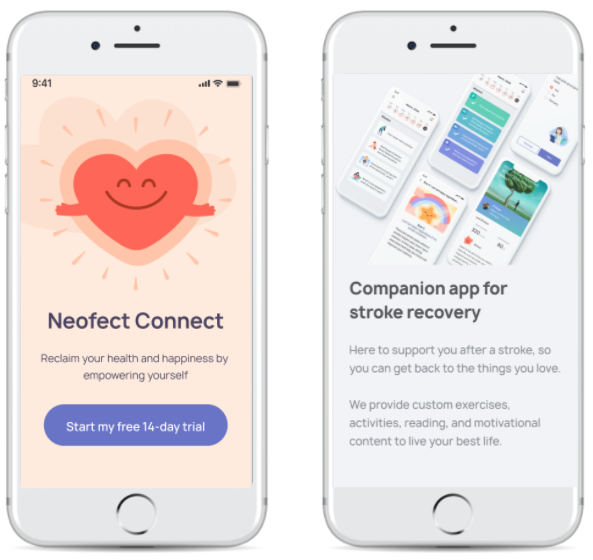Neofect behavior change content
Product: Neofect Connect
Neofect Connect is a behavior change app focused on improving recovery and overall health after stroke. Users received daily readings to educate, motivate, and support.
The readings were written in a conversational style. We wanted the user to feel like they have an empathetic, friendly expert in their pocket.
How I helped:
Wrote daily content using a friendly voice on all topics from sleep, to meditation, to doing laundry.
Mapped daily content delivery in the content management system.
Collaborated on brand characteristics and style guide
Articles
Sleep
Raise your hand if you’ve ever skimped on a full night's sleep before. 🙋 Does it make you feel groggy and foggy the next day? Is it hard to think and focus? Absolutely!
Even when we think we’re functioning just fine with a little sleep, it will eventually catch up with us. The brain actually requires sleep to detoxify proteins that are built up during waking hours. It also helps solidify working memory. After a stroke, when we’re in the process of building new neural connections, sleep is essential for recovery.
Sleep problems are really common after a stroke, so don’t beat yourself up about it if it doesn’t come easy. Let’s talk about some habits to try first. Later we’ll talk about specific sleep disorders and what can be done for those. Good sleep habits are called sleep hygiene. Just like washing our bodies and brushing our teeth, these are habits to keep us healthy!
Good sleep habits
Try to wake up and go to bed at the same time every day
Get outside every day for some light and fresh air
Include some form of exercise or movement in your routine every day
Try to avoid screens for 30 minutes before bed
Limit caffeine intake
If possible, avoid eating or watching tv in bed, so your brain knows when you’re in bed it’s sleep time
Strategies for falling and staying asleep
Have a bedtime routine
Try a sleep meditation before bed
Keep the room dark with blackout curtains
Try earplugs or a white noise machine
Don’t feel overwhelmed with doing them all. Changing habits can be hard. Try one or two and see if it helps.
Look how far you’ve come with creating new habits. You’re showing up here every day and together we’re creating a happy, healthy life.
Aerobic exercise
It’s common for people who have had a stroke to become deconditioned. They may have limited movement and may struggle with depression.
Aerobic exercise is important after stroke because it improves the function of the heart and lungs, which can reduce the risk of heart disease and future strokes.
Aerobic exercise has also been shown to boost mood and improve cognition in people post-stroke, specifically information processing and motor learning tasks.
What is aerobic exercise?
Aerobic exercise is training your heart to pump blood at higher rates, so it can practice recovering to a “normal” or resting rate.
Aerobic exercise is also called cardiovascular training. You might know it as just “cardio”.
The word cardio means heart and the word vascular refers to the blood pumping.
Think of aerobic exercise as working out your heart muscle.
How do I start?
Start slow. You don’t want to overdo it. Always check with your physician before starting an exercise program.
Each person is at a different level, so you have to find where you're at and go from there.
The two things you want to look for are:
increased rate of breathing
increased heart rate
How much should I do?
The American Heart Association recommends people with stroke participate in aerobic exercise for 20-60 minutes, 3-5 days a week. The recommended method is treadmill training if able.
If you’re unable to safely use a treadmill or walk outside, there are several other ways to get the heart pumping and increase the rate of breathing. Remember those are the key ingredients in aerobic exercise. A recumbent bicycle, hand bicycle, or rowing machine are a few options. You might also try a punching bag or chair aerobics.
Meditation
Meditation has specifically been studied in people with stroke and has been shown to improve balance, fatigue, depression, and disability.
One hypothesis about why meditation helps us is that it gets us out of the automatic responses we have.
By stepping back and being aware of what we’re feeling in our body in a non-judgemental way, different areas of our brain light up.
Before stroke, most of the things you did were probably on auto-pilot. You didn’t have to think about it.
Now all of a sudden, you’re forced to think about it. There are little things that were easy and now seem out of reach. It’s common to bombard ourselves with judgments.
While self-judgment is a very typical response, it’s probably not the healthiest for our overall well-being and recovery.
Meditation is about observation and awareness. It’s not about emptying the mind.
When those negative or distracting thoughts come up. We acknowledge them and allow ourselves to return to the breath.
The breath is our anchor. It is something that no matter where we are, we always have with us.
It returns us to the present. It’s this ability to return to the present that makes meditation so powerful.
It’s an intentional practice that needs time to develop, but you’ll find that you can begin to take these tools with you throughout your day.
Mindfulness-Based Stress Recovery programs by John Kabat-Zinn have been used in stroke research and are a great place to start.
20 minutes of daily meditation is the recommended dosage, but if you’re new to meditation, aim for 5 minutes a day and increase as you feel the benefits.

